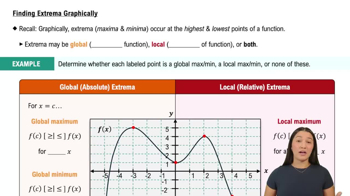Table of contents
- 0. Functions7h 52m
- Introduction to Functions16m
- Piecewise Functions10m
- Properties of Functions9m
- Common Functions1h 8m
- Transformations5m
- Combining Functions27m
- Exponent rules32m
- Exponential Functions28m
- Logarithmic Functions24m
- Properties of Logarithms34m
- Exponential & Logarithmic Equations35m
- Introduction to Trigonometric Functions38m
- Graphs of Trigonometric Functions44m
- Trigonometric Identities47m
- Inverse Trigonometric Functions48m
- 1. Limits and Continuity2h 2m
- 2. Intro to Derivatives1h 33m
- 3. Techniques of Differentiation3h 18m
- 4. Applications of Derivatives2h 38m
- 5. Graphical Applications of Derivatives6h 2m
- 6. Derivatives of Inverse, Exponential, & Logarithmic Functions2h 37m
- 7. Antiderivatives & Indefinite Integrals1h 26m
- 8. Definite Integrals4h 44m
- 9. Graphical Applications of Integrals2h 27m
- 10. Physics Applications of Integrals 2h 22m
5. Graphical Applications of Derivatives
Intro to Extrema
Problem 4.1.11
Textbook Question
Use the following graphs to identify the points (if any) on the interval [a, b] at which the function has an absolute maximum or an absolute minimum value <IMAGE>
 Verified step by step guidance
Verified step by step guidance1
Examine the graph of the function over the interval [a, b] to identify any critical points. Critical points occur where the derivative is zero or undefined, which often correspond to peaks, troughs, or points of inflection on the graph.
Identify the endpoints of the interval [a, b]. The absolute maximum or minimum can occur at these endpoints, so they should be considered in your analysis.
Look for any local maxima or minima within the interval. These are points where the function changes direction, which can be identified by observing where the slope of the tangent (derivative) changes from positive to negative (local max) or negative to positive (local min).
Compare the function values at the critical points and the endpoints. The absolute maximum is the highest function value, and the absolute minimum is the lowest function value within the interval.
Verify your findings by ensuring that the identified points are indeed within the interval [a, b] and that no other points within the interval have higher or lower function values than those identified.
 Verified video answer for a similar problem:
Verified video answer for a similar problem:This video solution was recommended by our tutors as helpful for the problem above
Video duration:
2mPlay a video:
Was this helpful?
Key Concepts
Here are the essential concepts you must grasp in order to answer the question correctly.
Absolute Maximum and Minimum
An absolute maximum of a function on a given interval is the highest value that the function attains within that interval, while an absolute minimum is the lowest value. These extrema can occur at critical points, where the derivative is zero or undefined, or at the endpoints of the interval. Understanding how to identify these points is crucial for analyzing the behavior of the function.
Recommended video:

Finding Extrema Graphically Example 4
Critical Points
Critical points are values in the domain of a function where the derivative is either zero or does not exist. These points are significant because they are potential locations for local maxima and minima. To find absolute extrema, one must evaluate the function at these critical points as well as at the endpoints of the interval.
Recommended video:

Critical Points
Closed Interval Method
The Closed Interval Method is a technique used to find absolute extrema of a continuous function on a closed interval [a, b]. This method involves evaluating the function at the endpoints a and b, as well as at any critical points within the interval. The largest and smallest of these values will determine the absolute maximum and minimum, respectively.
Recommended video:

Intro to Applied Optimization: Maximizing Area

 5:58m
5:58mWatch next
Master Finding Extrema Graphically with a bite sized video explanation from Callie
Start learning




